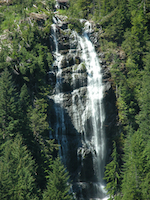The rest of the country seems to think that because it rains all the time here in Seattle that we have more than enough water.
 The rest of the country seems to think that because it rains all the time here in Seattle that we have more than enough water. I'll let you in on a little secret - not true.
The rest of the country seems to think that because it rains all the time here in Seattle that we have more than enough water. I'll let you in on a little secret - not true.
OK, it does seem to rain pretty much every day from November until April, but it doesn't generally come down in any quantity. We mostly get mist in the winter and in the summer we don't get a drop for months at a time.
Year round we get our drinking water from reservoirs that capture that rain and snow melting in the mountains.
Because we're so dependent on a "weather-generated water resource,"
a recent article on Marketing:green from MediaPost helped me put corporate water use in perspective:
Today, while flooding, drought, climate change and an aging water infrastructure set us on a path toward worldwide water crisis, water is more valuable than ever.
But the question on the minds of marketers should not be the value of water, but rather, the cost.
A major coffee retailer saved 6 million gallons of drinking water by turning off faucets that had previously been running continuously. Similarly, a major shopping chain was able to cut water usage by 30% across 70 locations by installing water-saving toilets.
It is easier than ever for companies to change their water habits. By launching company-wide conservation initiatives and using new affordable water purification and recycling appliances, some of our most recognizable brands have been able to reduce their water footprint by 80% to 90%, all the while scaling back energy costs and safeguarding their businesses against future water challenges.
Let's look at the big picture; water use - and conservation - throughout the supply chain.
 The rest of the country seems to think that because it rains all the time here in Seattle that we have more than enough water. I'll let you in on a little secret - not true.
OK, it does seem to rain pretty much every day from November until April, but it doesn't generally come down in any quantity. We mostly get mist in the winter and in the summer we don't get a drop for months at a time.
Year round we get our drinking water from reservoirs that capture that rain and snow melting in the mountains.
Because we're so dependent on a "weather-generated water resource," a recent article on Marketing:green from MediaPost helped me put corporate water use in perspective:
The rest of the country seems to think that because it rains all the time here in Seattle that we have more than enough water. I'll let you in on a little secret - not true.
OK, it does seem to rain pretty much every day from November until April, but it doesn't generally come down in any quantity. We mostly get mist in the winter and in the summer we don't get a drop for months at a time.
Year round we get our drinking water from reservoirs that capture that rain and snow melting in the mountains.
Because we're so dependent on a "weather-generated water resource," a recent article on Marketing:green from MediaPost helped me put corporate water use in perspective:









